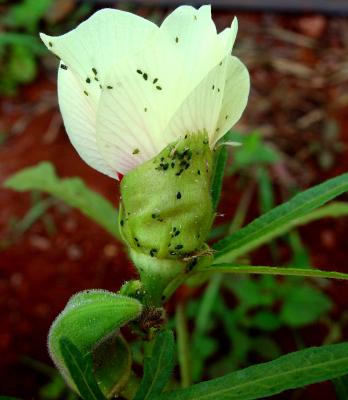


Main aphids in Africa: Black bean aphid ([i]Aphis fabae[/i]), Cabbage aphid ([i]Brevycoryne brassicae/Myzus persicae[/i]), Groundnut aphid ([i]A.craccivora[/i]), Cotton aphid ([i]A.gossypii[/i]), Russian wheat aphid ([i]Diuraphis noxia[/i]), Cypress aphid ([i]Cinara cupressi[/i])
Aphids (Aphis gossypii)
The cotton aphid (Aphis gossypii) is common on cucurbits, including watermelons. Colonies of green to blackish aphids are found on tender shoots, mainly on the lower leaf surface, where they suck sap. The growth of the attacked shoots is stunted and the leaves are curled and twisted. Aphids excrete honeydew, which leads to growth of sooty mould, and may attract fruit flies. Aphids, in particularly winged aphids, transmit virus diseases (e.g. cucumber mosaic virus) when feeding from plant to plant.
- Plant barrier crops.
- Use sticky traps to monitor aphids.
- Use botanicals (e.g. neem extracts).
- Use reflective mulch (e.g. a polyethylene sheet covered with a thin layer of aluminium that is spread out on the growing bed at planting time). Covering the ground with a material like aluminium foil repel winged aphids, delay aphid colonisation and may delay virus infection.
